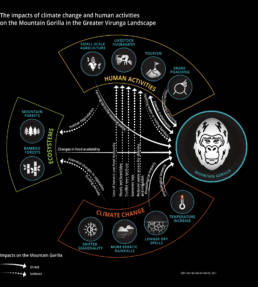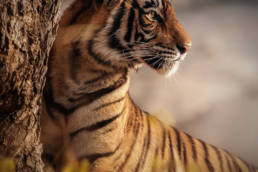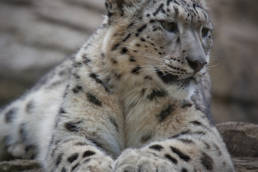Mountain Gorilla
~ 1.000 worldwide
Mountain Gorilla
Introduction
There are two species of gorilla, the eastern gorilla (Gorilla beringei) and western gorilla (Gorilla gorilla), which are geographically separated by the inner Congo Basin. The eastern species of gorilla consists of two sub-species, the mountain gorilla (Gorilla beringei beringei) and eastern lowland gorilla or Grauer’s gorilla (Gorilla beringei graueri).
These two gorilla species have numerous similarities: both are large-bodied with adult males weighing up to 200kg and females around half that. In both, adult males are known as “silverbacks” due to the characteristic silver hair that develops on their backs from maturity. Gorillas are almost completely vegetarian, unlike chimpanzees. They live in social groups of between 7 and 16 individuals, comprised of one dominant silverback male, three or four females, and four or five of their offspring. However, large groups of almost 40 individuals have been encountered. Gorillas usually sleep in nests that they have built on the ground, although sometimes they nest in trees. Gorillas live up to 50 years. They are peaceful animals, but can be aggressive, particularly the silverback, who will fiercely defend his family.
Where they can be found
The mountain gorilla is found in two isolated subpopulations, the first within the Virunga Volcanoes region straddling the border between Rwanda (Volcanoes National Park), Uganda (Mgahinga Gorilla National Park), and the Democratic Republic of Congo (Virunga National Park), and the second within the Bwindi Impenetrable National Park (Uganda) and adjacent Sarambwe Nature Reserve (DR Congo).
The Virunga mountain gorillas are the best known of all gorilla populations, having been studied since 1967 and made famous through the work of primatologist Dian Fossey. The most recent survey in 2016 shows that the population has increased to 604 individuals from an estimated 480 in 2010. When combined with published figures from Bwindi Impenetrable National Park, this brings the global wild population of mountain gorillas to an estimated 1,004 and makes it the only great ape in the world that is thought to be increasing in population. Considering the positive trend, mountain gorillas are now listed as Endangered on the IUCN Red List. Mountain gorillas are also listed under Appendix I of the Convention on International Trade in Endangered Species of Fauna and Flora (CITES). CITES prohibits the international trade of Appendix I species, apart from exceptional cases.
© Max Planck Gesellschaft
Why they are important
Mountain gorillas and humans share a common ancestry, and apart from orangutans, chimpanzees and bonobos, are more alike to us than any other species on Earth. They and other primates hold the key to understanding our evolutionary past. Increasingly, mountain gorillas are a prized ecotourism destination, generating income for all three governments and contributing significantly to local development.
How they are threatened
Despite their increasing population, mountain gorillas are still considered endangered by the International Union for Conservation of Nature (IUCN)’s Red List of Threatened Species. They remain highly vulnerable to threats such as habitat degradation or indiscriminate poaching (as illegal wire or rope snares intended to ensnare other species can kill or maim them). As their genes are 98-per-cent identical to human genes, gorillas are also susceptible to diseases that affect humans, including Ebola, anthrax, Marburg viruses and respiratory diseases.
With more than 600 people/km2, the Greater Virunga Landscape has one of the highest human population densities in rural Africa. Human pressure around the protected areas of this landscape is extremely high due to local communities’ heavy dependence on natural resources. The farms and human settlements surrounding the protected areas have heavily restricted the mountain gorillas’ remaining habitat. The pressure is such that the gorilla population may soon reach carrying capacity.
It is expected that climate change will increasingly exacerbate adverse impacts, intensifying existing challenges and creating new combinations of risks. While mountain gorillas are thought to be an adaptable species in the face of climate change, changes in human behaviour in response to climate change are also likely to affect them. These are known as the “indirect impacts of climate change” on mountain gorillas. Communities in the Greater Virunga Landscape are particularly vulnerable to climate change because of their heavy dependence on natural resources and subsistence farming and the absence of alternative livelihood options. Reduced water availability may lead to increased collection of drinking water inside national parks and further interference with the species.
The graph above shows the complex web of the interacting impacts of climate change and human activities, and how they could affect mountain gorillas. In the Greater Virunga Landscape, the Democratic Republic of the Congo, Rwanda and Uganda are already experiencing the impacts of a changing climate. Rising temperatures and ever more frequent extreme weather events could both have physiological impacts on gorillas. As an example, certain individuals have been observed using open water points, a new water drinking behaviour rarely recorded in the past. In addition, climate change impacts on ecosystems could also affect food availability for the species. Importantly, higher temperatures and more erratic rainfall will also likely lead to harvest loss and increasing food insecurity for local communities living in the vicinity of the mountain gorillas’ habitat. In compensation for livelihood losses, local people could increasingly partake in illegally extracting natural resources from the national parks, searching for drinking water, cutting down bamboo or setting snares. Unselective snare hunting can kill or injure mountain gorillas, and the increased disturbance can exacerbate the risk of disease transmission and habitat degradation.
For more information: Mountain Gorilla – Species Brief


